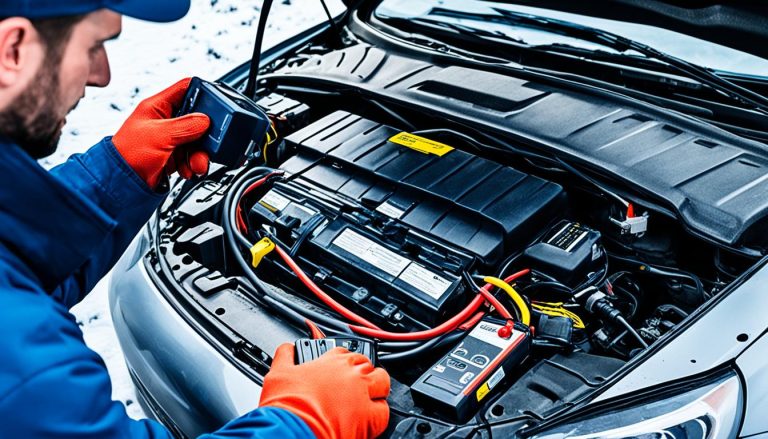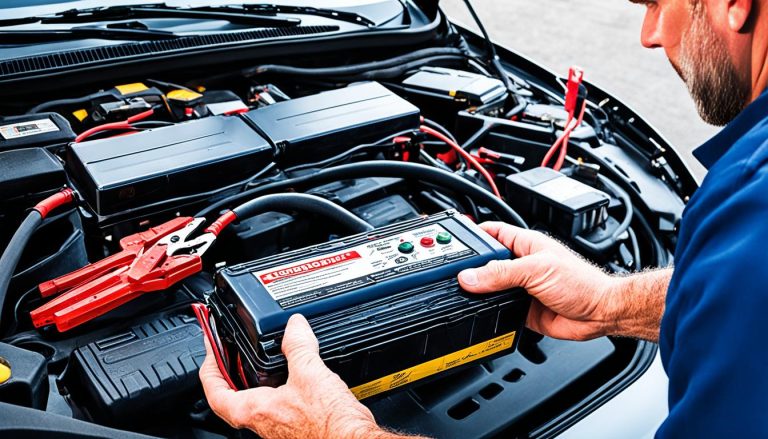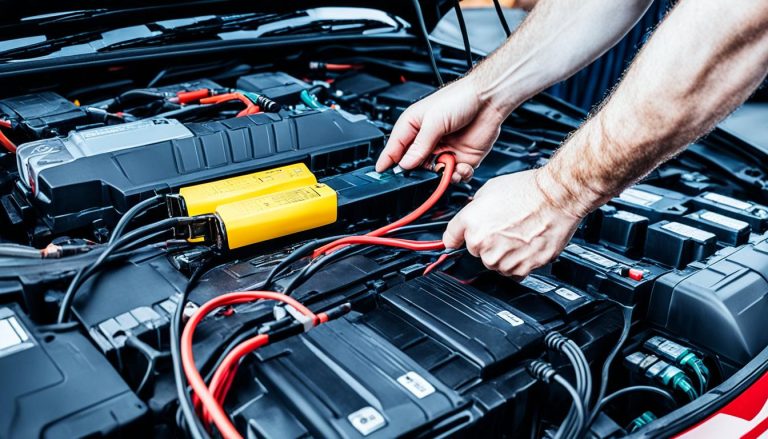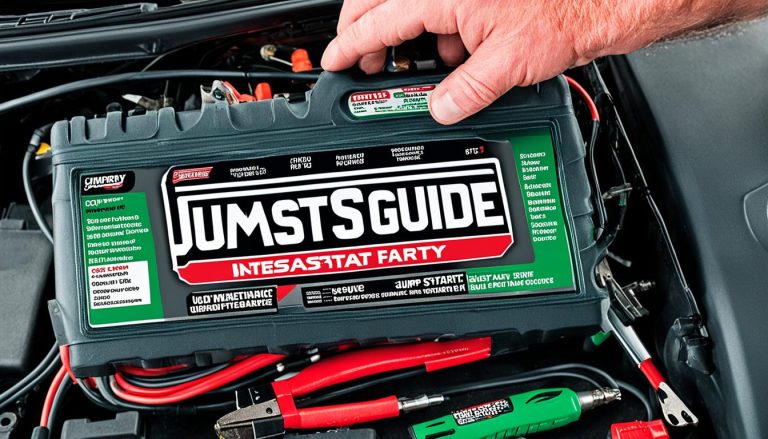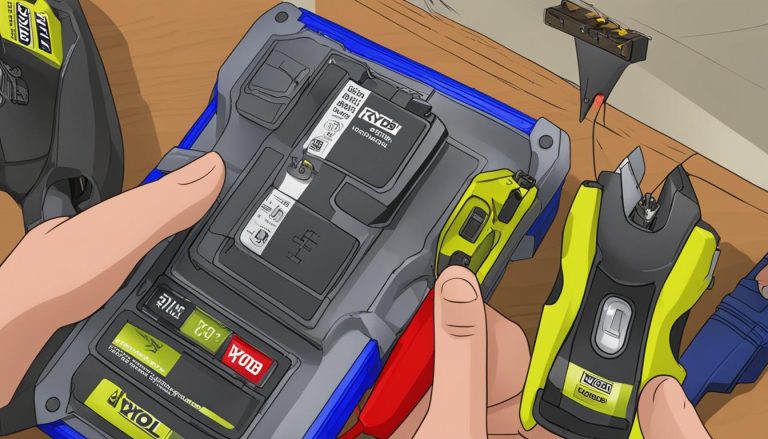Battery Dead Won’t Jump Start? Quick Fixes Here!
batterychargers.site and its partners may earn a commission if you purchase a product through one of our links
Have you ever found yourself with a battery dead won’t jump start situation? It’s a perplexing scenario: your car won’t start even with a jump, leaving you scratching your head and asking – how do you jump start a dead battery when it refuses to come back to life? It’s a common enough headache for drivers, one that can be spawned by issues ranging from terminal corrosion to a failed alternator. Don’t worry, this guide is here to inject some charge into your troubleshooting efforts and get you back on the road.
Key Takeaways
- Identify simple solutions when your car won’t start even with a jump.
- Understand the common culprits behind a dead battery and why it might not respond to a jump start.
- Learn the importance of proper maintenance to avoid recurrent dead battery issues.
- Gain knowledge on the correct techniques for jump-starting your vehicle.
- Recognize when a dead battery might signify a larger electrical system problem.
- Educate yourself on basic checks you can perform before calling for professional help.
- Discover the critical role of high-quality jumper cables in successful jump starting.
Understanding Why Your Battery Dead Won’t Jump Start
When you find yourself with a car that won’t turn over, it’s not just frustrating; it’s concerning. Understanding the possible reasons behind why your car battery is dead and won’t start, even with a jump, is the first step in diagnosing and fixing the problem. Let’s delve into some common causes and factors that could be at play with a non-responsive battery, so you can get back on the road as swiftly as possible.
Possible Causes of a Non-Responsive Dead Battery
If your battery won’t hold charge, it might be due to being fully depleted, which can occur from leaving lights on or electrical accessories plugged in when the car is off. Age is another factor since battery capacity diminishes over time. Typically, a battery will last between three to five years, but this can vary based on usage and weather conditions.
How a Fully Depleted Battery Affects Jump Starting
A jump start relies on a transfer of power from a donor vehicle’s battery. However, if your car battery is not charging, it might not accept or hold enough charge to start your car due to being fully depleted. Persistent depletion degrades a battery’s cells and can prevent it from being rejuvenated by a jump start.
The Role of Battery Terminals and Cables in Jump Starts
The effectiveness of a jump start is not solely dependent on the state of your battery; the condition of your battery terminals and cables is just as important. Any corrosion or looseness can result in a poor connection, making it impossible for the charge to flow from the donor battery to yours. Ensuring that these connections are clean and secure is vital to a successful jump start.
When troubleshooting a car battery that’s dead and won’t start, consider the following table for common symptoms and possible issues:
| Symptom | Possible Issue |
|---|---|
| No dashboard lights | Completely dead battery or major electrical problem |
| Clicking sound when turning the key | Weak battery charge or faulty starter motor |
| Battery warning light is on | Alternator issues or faulty electrical system |
| Swollen battery case | Excessive heat or overcharging |
Therefore, when your battery seems like it’s dead and a jump start isn’t the solution, remember to inspect beyond just the battery itself. Checking the health and connectivity of the entire starting system can lead you to the root cause and closer to a fix.
Inspecting the Car Battery and Jump Start Procedure
When your car won’t start after a jump, it’s essential to assess the battery’s health and the jump start process. A meticulous examination and following the correct steps can ensure that your battery receives the best possible chance at recovery and function.
Verifying the Health of Your Car Battery
If you’re encountering issues where a jump start is not working, it’s imperative to verify the health of your car battery. Check for signs of aging, as a battery older than three years may be nearing the end of its lifecycle. Also, keep an eye out for symptoms such as dimming headlights or a slow engine crank, which may indicate deeper alternator issues.
Correct Way to Attach Jumper Cables
Attaching jumper cables properly is crucial to a successful jump start. Ensure that the clamps are securely attached to the corresponding terminals of both batteries, and that the donor vehicle’s engine is running to provide an adequate charge.
Quality and Length of Jumper Cables Matter
The effectiveness of a jump start isn’t solely dependent on the process but also on the jumper cables themselves. Use high-quality cables of appropriate length to avoid power loss, ensuring they’re not excessively long to prevent resistance from hindering the power transfer.
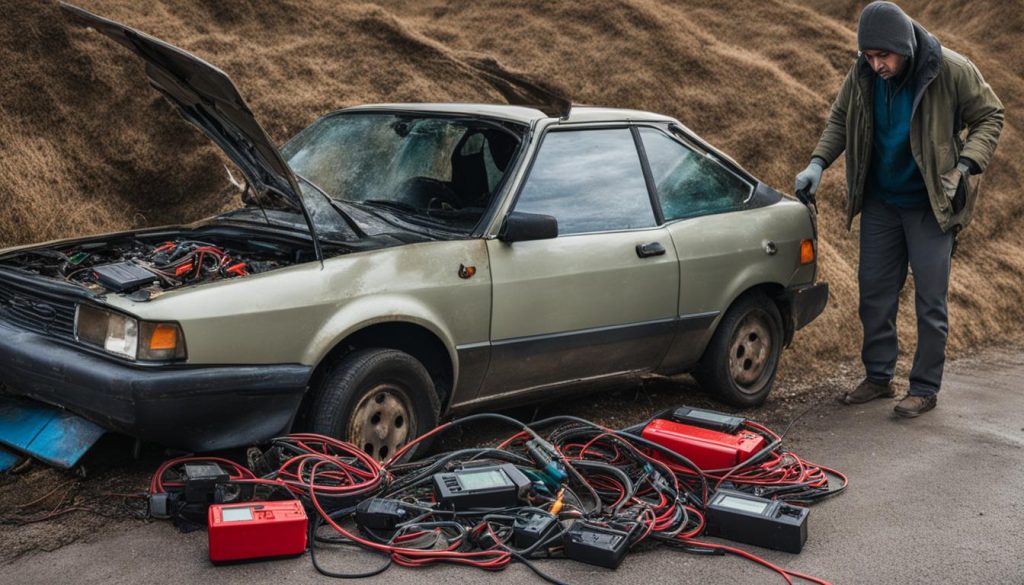
| Battery Checkpoint | Desired Condition |
|---|---|
| Age of Battery | Less than three years old |
| Physical Condition | No visible bulging, cracks, or leaks |
| Headlights Brightness | Consistently bright when turned on |
| Engine Crank Sound | Robust and immediate when starting the car |
By following these guidelines, troubleshooting why your car won’t start after a jump becomes more systematic, increasing the chances of identifying the root cause and correcting it effectively.
When a Dead Battery Indicates a Larger Issue
Encountering a car battery not turning over can be frustrating, and while a jump might seem like the quick fix, it doesn’t always work. Often, this could be an alert to deeper problems within your vehicle’s electrical system. Let’s examine four major culprits that might be hiding behind the façade of a dead battery: a defective alternator, a failed starter, a damaged neutral safety switch, or other underlying issues.
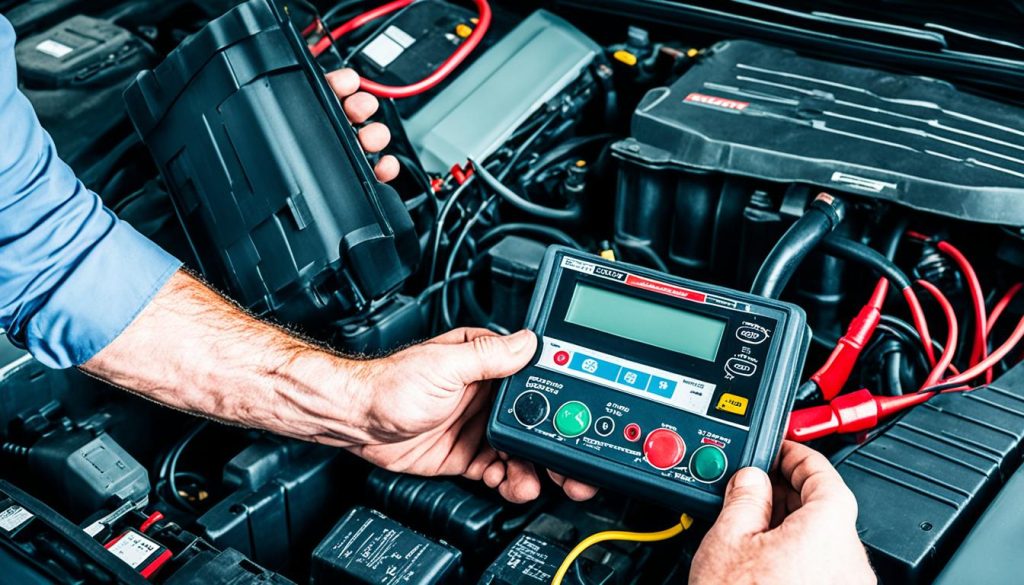
Firstly, a defective alternator can be masquerading as a battery problem. The alternator is responsible for recharging the battery while your vehicle is running. If it fails, the battery depletes and leaves you stranded. Furthermore, a failed starter motor can mimic a dead battery. Clicking sounds or the total absence of cranking noise may point to a starter issue. Lastly, the neutral safety switch in automatic transmission vehicles ensures your car only starts in park or neutral. If damaged, it may prevent the car from cranking, giving the impression of a dead battery.
In the table below, we’ve delineated some telltale signs that can help you distinguish between a simple battery fault and more significant concerns requiring professional diagnosis and repair.
| Component | Signs of Failure | Potential Impact on Battery/Starting |
|---|---|---|
| Alternator | Dimming lights, battery warning light on dashboard, accessories failing | Battery not charging properly, resulting in a car that won’t start |
| Starter | Clicking sound when key is turned, the engine doesn’t turn over | Car battery appears dead due to the starter failing to crank the engine |
| Neutral Safety Switch | Vehicle does not start in park or neutral, no reaction from starting system | Simulates a dead battery by preventing the car from cranking |
Remember, while a deficient battery can often be the culprit, it’s not always to blame. Your car not starting can unravel an entirely different narrative – one involving a defective alternator, a failed starter, or a damaged neutral safety switch. Don’t overlook these potential issues, as they could save you from future inconvenience and unforeseen costs.
DIY Checks Before Seeking Professional Help
When faced with a battery dead won’t jump start situation, it’s beneficial to know a few troubleshooting steps you can undertake before reaching out for professional aid. With some basic mechanical knowledge, you can determine whether it’s a simple fix or something that requires an expert’s touch. Here are some DIY checks that could save you both time and money.

Cleaning Corroded Battery Terminals
Corrosion on your battery terminals can prevent your car from starting, even with a jump. Fortunately, cleaning the terminals is a straightforward task that can restore the electrical connection. Use a wire brush and a mixture of water and baking soda to scrub away the corrosion. Rinse with clean water and dry thoroughly before attempting to jump start again.
Tightening Loose Cable Connections
A loose connection can also be the culprit behind why your car won’t jump start. Ensuring that all cable connections to the battery are tight and secure is an easy step that can make a world of difference. Check each terminal – if you can twist them by hand, they need to be tightened using a wrench.
Evaluating Your Alternator’s Performance
An alternator in poor health can lead to a drained battery. Checking the alternator’s health requires you to be vigilant for signs of failure, such as dimming headlights or the battery warning light on your dashboard. If these symptoms are present, it’s a strong indication that your alternator may need attention or replacement.
| DIY Check | Tools Required | Troubleshooting Steps | Indications of Success |
|---|---|---|---|
| Battery Terminals | Wire brush, water, baking soda | Clean off corrosion, rinse and dry | No more white or blue powdery substance, secure connection |
| Cable Connections | Wrench | Tighten cable clamps on terminals | Terminals cannot be moved by hand |
| Alternator Health | None | Look for dimming lights or warning lights | Lights maintain brightness, no dashboard battery light |
Battery Dead Won’t Jump Start: Steps to Troubleshoot
If your car won’t roar to life even after a jump start, first check for an empty gas tank—no fuel, no start. It’s a simple oversight that can leave anyone perplexed. Once you’ve ruled this out, it’s time to look under the hood. Begin with the battery terminals; a thorough cleaning may be in order if you spot any corrosion. Afterward, re-tightening the cables ensures they make solid, efficient contact. This quick maintenance can be the difference between a non-starter and a smoothly running engine.
Still no luck? It’s possible the heart of the issue lies deeper in your vehicle’s systems. A reliable set of fuel system checks could unveil a clogged fuel filter or a malfunctioning fuel pump, both of which are vital for getting your engine the fuel it needs. Ignition switch failure is another common culprit behind starting troubles, so have that checked if the battery and fuel supply are accounted for. For those driving manual transmission vehicles, pay extra attention to the manual transmission safety switch, which could also inhibit the engine from starting if it’s damaged.
Persistent starting issues can signal the need for a more in-depth look by a professional. Regular service, adhering to maintenance schedules, and keeping tabs on your battery’s voltage can help you avoid unpleasant surprises and extend the life of your battery. Taking a moment for these assessments can save you time and ensure you stay on the road safely.
FAQ
What should I do if my battery is dead and won’t jump start?
If your battery is dead and won’t jump start, first check that the jumper cables are properly attached and that the battery terminals are clean and secure. If the issue persists, the battery may be completely depleted or damaged, and you may need to replace it or seek professional help.
How can I tell if my dead battery is affecting the jump-start?
If your car’s battery is fully depleted, it may not have enough residual charge to respond to a jump-start. Signs of a completely dead battery include no dashboard lights or sounds when you turn the key.
Why are the battery terminals and cables important for a successful jump-start?
Battery terminals and cables are crucial for conducting electrical current to the starter and the rest of the vehicle. If they are corroded or loosely connected, they may prevent the necessary current from being transferred during a jump start.
How do I verify the health of my car battery?
To verify the health of your battery, check its age (if it’s older than three years, it may be prone to issues), look for warning signs like dimming lights or a battery warning light, and consider having a voltage test performed.
What is the correct way to attach jumper cables?
To properly attach jumper cables, connect the red clamp to the positive terminal of the dead battery and the donor battery, and the black clamp to the negative terminal of the donor battery and an unpainted metal surface on the engine block or chassis of the car with the dead battery. Ensure the clamps have a solid connection and are not touching each other.
Do the quality and length of jumper cables affect the jump-start process?
Yes, the quality and length of jumper cables can affect a jump start. Low-quality or excessively long cables may not deliver enough power due to increased resistance or inadequate current capacity.
Can a dead battery indicate a more significant problem with my car?
A dead battery that won’t jump start could point to a more significant issue, such as a defective alternator, a failed starter, or a damaged neutral safety switch. These problems will likely require professional diagnosis and repair.
What are some DIY checks I can do before going to a mechanic?
Before consulting a mechanic, you can clean corroded battery terminals, tighten any loose cables, and check your alternator’s performance for signs of failure, such as dimming lights or a battery warning light on your dashboard.
What steps can I take to troubleshoot a dead battery that won’t jump start?
To troubleshoot a dead battery that won’t jump start, ensure your gas tank isn’t empty, clean any corrosion from the battery terminals, tighten cable connections, and check the fuel system and ignition switch for issues. In manual transmission vehicles, check the safety switch as well.

